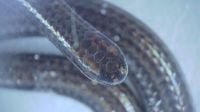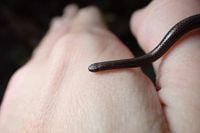For nearly two decades, the Barbados threadsnake, known as the world’s smallest snake, had eluded scientific observation, sparking fears it might have vanished forever. But in March 2025, a breakthrough moment arrived when Connor Blades, a project officer with Barbados’ Ministry of Environment, lifted a small rock in one of the island’s last patches of natural forest and spotted the elusive creature.
Measuring just 7.5 to 10 centimeters long and about two millimeters wide—roughly the size of a spaghetti noodle coiled on a coin—the Barbados threadsnake (Tetracheilostoma carlae) is a remarkable species. Blind and subterranean, it feeds primarily on termites and termite eggs, living a cryptic life beneath the soil where it’s easily mistaken for an earthworm. This rarity, combined with its tiny size, helps explain why it has only been documented a handful of times since its first scientific record in 1889.
Blades described the rediscovery as “quite an exciting find” and “one of the highlights of my career so far.” The tiny snake was found beneath a small rock in a forested area within the Scotland district, one of the few remaining natural woodlands on the island. This area’s hilly terrain and limestone outcrops have long served as a refuge for native biodiversity, even as Barbados has lost 98% of its primary forests since European colonization in the 16th century.
Confirming the snake’s identity was no small feat. The threadsnake closely resembles the invasive Brahminy blind snake (Indotyphlops braminus), which was introduced to Barbados in recent decades and is more common. To differentiate the two, Blades transported the specimen to the University of the West Indies, where microscopic examination revealed the threadsnake’s distinctive pale orange dorsal stripes and specific head scale patterns. “I tried to keep a level head,” Blades recalled, noting the difficulty in distinguishing the species by eye, especially since it was the first threadsnake the team had seen.
The rediscovery was part of the Conserving Barbados’ Endemic Reptiles (CBER) project, a collaborative effort between the Ministry of Environment and the international conservation group Re:wild. Justin Springer, Caribbean program officer for Re:wild, who was present at the find, reflected on the significance: “Rediscovering one of our endemics on many levels is significant. It reminds us that we still have something important left that plays an important role in our ecosystem.”
Barbados has seen a sevenfold increase in overall tree cover in recent decades, but the natural, moist forests that the threadsnake prefers remain scarce. This habitat loss, coupled with the snake’s low population density, raises concerns about its ability to find mates and sustain its population. Unlike some snakes that can reproduce without mating, the Barbados threadsnake reproduces sexually, with females laying only one large egg per clutch.
The snake’s rarity is further underscored by its sparse scientific record. After being misclassified for years, it was officially identified as a distinct species in 2008 by US biologist S. Blair Hedges, a professor at Temple University and director of its biology center. Hedges named it Tetracheilostoma carlae in honor of his wife. He recalled spending days searching for the snake and noted that at the time, only three specimens were known globally—two housed in a London museum and one in California, which had been mistakenly labeled as originating from Antigua.
“The ‘aha’ moment was in the laboratory,” Hedges said, referring to the genetic analysis that confirmed the threadsnake as the world’s smallest-known snake. Since then, scientists have received many mistaken reports from people confusing earthworms for the snake, highlighting how easily it can be overlooked.
Barbados’ biodiversity has suffered greatly due to habitat destruction and invasive species. Many endemic animals, such as the Barbados racer, Barbados skink, and Barbados rice rat, have gone extinct. The introduction of the Indian mongoose in the 1870s, intended to control rats, likely contributed to these losses. Against this backdrop, the threadsnake’s survival is a beacon of hope and a call to action.
Re:wild has included the threadsnake on its global list of 4,300 species “lost to science” that had not been seen for over a decade. Since 2017, fifteen of these species—including mammals, birds, reptiles, and plants—have been rediscovered, signaling that dedicated conservation efforts can yield remarkable results.
Moving forward, the CBER project plans to conduct continued surveys to map the threadsnake’s range and develop strategies to protect its critical habitat. The Scotland district, with its relatively natural forest and unique terrain, is a vital reservoir for the island’s biodiversity and offers hope for the threadsnake’s future.
“If the threadsnake population isn’t very dense, I’m worried about their ability to find mates—particularly if their habitat is under threat and being degraded,” Blades said. The rediscovery not only revives interest in this tiny serpent but also underscores the urgent need to safeguard Barbados’ remaining natural environments for the benefit of all its endemic species.
As Springer put it, “The threadsnake’s rediscovery is also a call to all of us as Barbadians that forests in Barbados are very special and need protection—not just for the threadsnake, but for other species as well. For plants, animals, and our heritage.”


